Contents
Market Overview
Georgia may mean higher U.S. rates temporarily, but not necessarily lower equities nor a stronger USD. Instead, the key will lie with U.S. rates’ implied volatility, which correlates more strongly with EMFX, at least over wider U.S. breakevens and 5y5y inflation swaps. In the aftermath of the GA result, Biden certification and subsequent riots, the market shifted back to the opportunistic reflation strategy that we first highlighted last August as U.S. equities rallied 1.1-1.5% and the VIX tailed down to 21. Over the week, we saw U.S. Treasuries widen 17-21bp, U.S. breakevens trade above 2.10% and 5y5y inflation swaps break-out to 2.36%, but the U.S. also recorded negative ADP and NFP employment reports. FOMC minutes flagged a benign outlook, but Fed speakers were more hawkish around tapering. This ought not to be confused with the $29bn reduction in the Fed balance sheet this week, which comes as pandemic facilities rolled off at year-end. Away from U.S. markets, OPEC+ agreed to delay adding 500k boepd which lifted crude oil by 6.7%. Despite the move in U.S. rates, EM Credit held up well with Sovereign Credit only down -0.9% and EM Local Currency down -0.6%. We note that Lebanon, Zambia & Angola outperformed, while Ecuador, Sri Lanka & Bolivia lagged. Needless to say, we still witnessed strong inflows this week into EM, as the asset class outperformed US IG considerably. This comes as EM fixed income drew $17bn in inflows in 2020, after $67bn in 2019 and $19bn in 2018. It is also worth noting that JPM revised their EM default rate to 2.5% for the year ahead, adding further comfort for the investment outlook in 2021.
While U.S. political developments will govern most market moves before Biden’s Inauguration, the EM calendar is beginning to fill up once again. Rate decisions from Peru (0.25%), Poland (0.10%) and South Korea (0.50%) stand out. Meanwhile, China will report CPI and PPI inflation data, along with export and import releases. Inflation out of Argentina, Brazil, Czech Republic, Hungary, India, Israel, Poland and Romania are also due, where India and Israel may confirm deflationary trends that we saw in 2020. Otherwise, we can expect attention to focus on Turkey’s current account release and Mexico’s industrial production.
Fixed Income
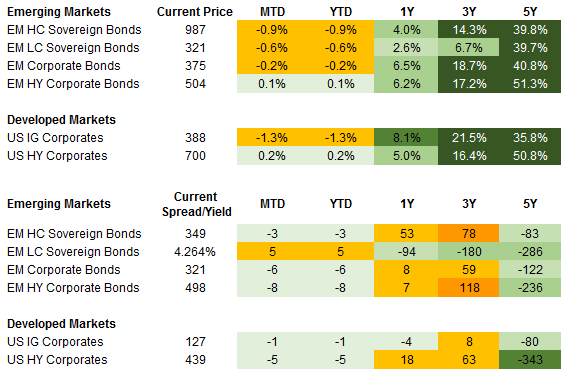
Equities
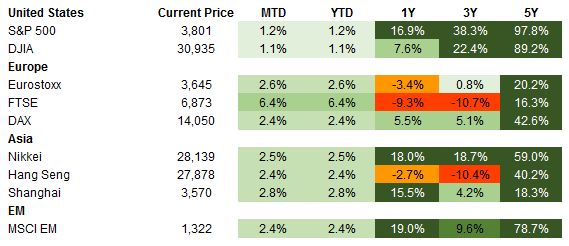
Commodities

Source for data tables: Bloomberg, JPMorgan, Gramercy. EM Fixed Income is represented by the following JPMorgan Indicies: EMBI Global, GBI-EM Global Diversified, CEMBI Broad Diversified and CEMBI Broad High Yield. DM Fixed Income is represented by the JPMorgan JULI Total Return Index and Domestic High Yield Index. Fixed Income, Equity and Commodity data is as of January 8, 2021 (Mid Afternoon).
Emerging Markets Weekly Highlights
Democratic control of U.S. government is a “glass half full” for emerging markets on stronger growth prospects and foreign policy normalization, despite upward pressure on rates and inflation; A New Year’s gift by Saudi Arabia to the global oil market; COVID-19 cases rise across the globe, new virus strains increase tail risks for 2021; After a sudden about-face, NYSE continues with decision to delist Chinese companies allegedly threatening U.S. national security
Democratic control of U.S. government is a “glass half full” for emerging markets on stronger growth prospects and foreign policy normalization, despite upward pressure on rates and inflation
Event: The Democrats surprisingly won both runoff Senate races in the state of Georgia this week, gaining full control of the U.S. Congress for the next two years. A unified government in Washington materially improves the implementation outlook of incoming President Biden’s policy agenda, reviving the pre-November 3rd “Blue Wave” market narrative.
Gramercy commentary: As we wrote prior to the November elections, we believe that a “Blue Wave” scenario (i.e. the Democrats in control of both the White House and Congress) is on balance a favorable outcome for emerging markets (“EM”) as an asset class. Our view is anchored by expectations that further significant fiscal stimulus will materialize early in a relatively less constrained Biden Administration. This should provide a tailwind to GDP growth as the U.S. economy attempts to rebound from the COVID-19 shock and a difficult first quarter, with positive spillover effects for the global economy. On the flip side for EM, more generous fiscal stimulus combined with expected vaccine-driven pickup in U.S. domestic demand/economic activity as 2021 progresses is likely to prove reflationary, elevating UST yields and putting pressure on EMD duration. This being said, we anticipate the Fed’s highly accommodative policy stance to remain unchanged over our investment horizon, given what we expect to be a still fragile economic recovery this year. As such, massive liquidity provisions by the Fed and the other systemic central banks is here to stay, continuing to provide support to risk sentiment in global markets. While we think developed markets (“DM”) rates and inflation are set to start moving higher in the post-COVID-19 recovery, this will likely happen only gradually. As such, higher-yielding EM assets will remain relatively attractive in a global market environment characterized by a large share of DM instruments still trading at negative yields, incentivizing continuing inflows into the EM asset class. Last but not least, loose fiscal and monetary policy and likely larger twin deficits in the U.S., suggest to us that a weak USD environment should persist this year, creating a generally benign backdrop for EMFX amid accelerating growth. In our view, this is especially true for currencies such as TRY and RUB that retain significant catch-up potential vis-à-vis pre-COVID-19 valuations, while also enjoying supportive idiosyncratic stories.
A New Year’s gift by Saudi Arabia to the global oil market
Event: On January 5th, OPEC+ agreed to modifying their plan to gradually taper the historic cuts. The 2-month deal sees Russia and Kazakhstan increasing output by a token 75K b/d, the rest of OPEC+ maintaining production levels, andsurprisingly,Saudi Arabia unilaterally cutting production by 1 mb/d. Prince Abdulaziz, Saudi Arabia’s Minister of Energy, highlighted that their decision was completely unilateral and based on a desire to provide proactive leadership on softer demand expectations. He also stated that it was not correlated with the incoming Biden Administration / related to the restoration of ties with Qatar.
Gramercy commentary: We have been underwriting a very gradual recovery in oil prices based on a tapered resumption of production in line with rebounding demand. We qualify Saudi Arabia’s decision as a surprising, but positive outcome. Over the past 10 months, we have been particularly focused on the U.S. shale – OPEC reaction function (a key sensitive area for all OPEC+ members). Non-OPEC+ members benefit from a higher floor in oil prices; as such, the move by Saudi Arabia could be perceived as an “olive branch” to the onshore American producers. In a scenario where U.S. domestic production takes advantage of higher prices, we would expect a strain in Saudi-Russian relationships and the potential for a move by OPEC to impede a potential market share loss. In the meantime, we believe that the move is best understood as Russian Deputy Prime Minister Alexander Novak qualified it: a New Year’s gift to the oil market.
COVID-19 cases rise across the globe; new virus strains increase tail risks for 2021
Event: COVID-19 cases are surging across the globe, with many countries witnessing new highs in daily cases and governments struggling to enforce new lockdown measures. Over the past few weeks, virus resurgence has occurred in both Japan and China. Tokyo has declared a state of emergency after hitting daily record cases and China has locked down the town of Shijiazhuang (a city south of Beijing) to manage a local outbreak. To top it all off, new more contagious strains of the virus have been identified in the UK, South Africa and upstate New York.
Gramercy commentary: From our point of view, the virus resurgence continues to highlight two important factors for markets. First, significant challenges remain for policymakers deciding how best to handle the virus. Governments continue to ask citizens to comply with new lockdown measures, but must simultaneously combat the population’s lockdown fatigue. This dynamic will remain important at least until more progress is made with vaccinations. Second, the strong monetary policy support from the Fed and other global central banks seems to have maintained stability in the markets; however, the general consensus is that the global economy will recover in 2021. While the consensus is that the new strain of the virus seems to be responsive to the vaccine, we are watching closely for the potential tail risk that the virus mutates further complicating the vaccine timeline or effectiveness, a scenario that is not currently priced into markets.
After a sudden about-face, NYSE continues with decision to delist Chinese companies allegedly threatening U.S. national security
Event: The New York Stock Exchange is proceeding with its decision to delist three Chinese telecommunications companies after the U.S. Treasury objected to its shock decision last week to let the companies remain on the exchange. The decision follows President Trump’s executive order from November, which required investors to divest from Chinese businesses deemed a threat to national security. The NYSE first announced it would delist the companies on New Year’s Eve, then reversed itself days later as questions emerged regarding which companies should be banned. The latest decision represents a third reversal in compliance with the original executive order.
Gramercy commentary: The confusion has created considerable volatility with regards to the three Chinese companies in question. In Hong Kong trading Thursday, China Telecom dropped 9.4% and China Mobile fell by 7.2%. The companies respectively closed at their lowest since 2008 and 2006, respectively. The third target, China Unicom Hong Kong, declined 11%. The Chinese government responded that it would take the “necessary countermeasures to resolutely safeguard the legitimate rights and interests of Chinese companies,” but it has not provided specifics. While the delisting will certainly have an impact on these companies in the short term, we expect President-Elect Biden to put many of Trump’s last minute executive orders on hold in order to review and assess appropriate action more thoroughly. More broadly, the U.S.-China relationship will continue to be highly complex with ongoing areas of contention albeit the U.S. administration is likely to adopt a more nuanced and less antagonistic approach.
Emerging Markets Technicals
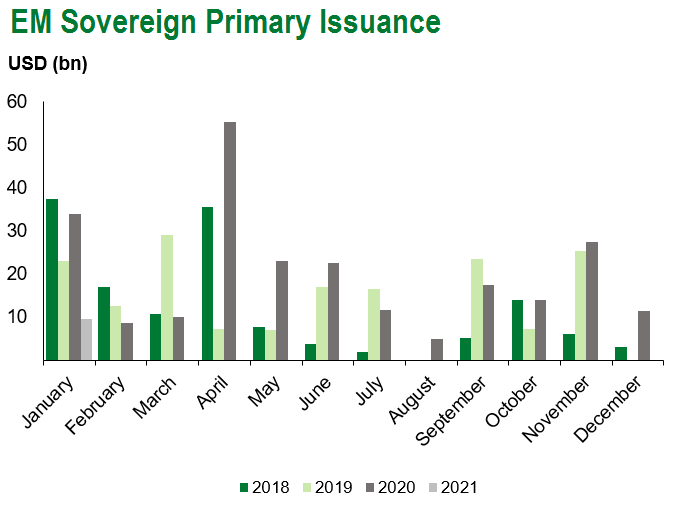
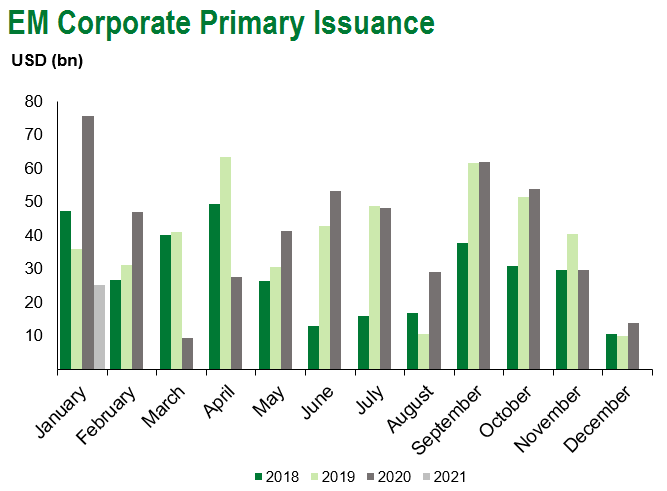
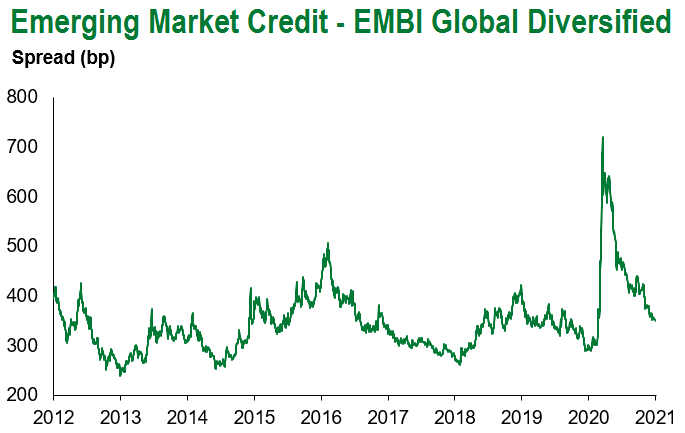
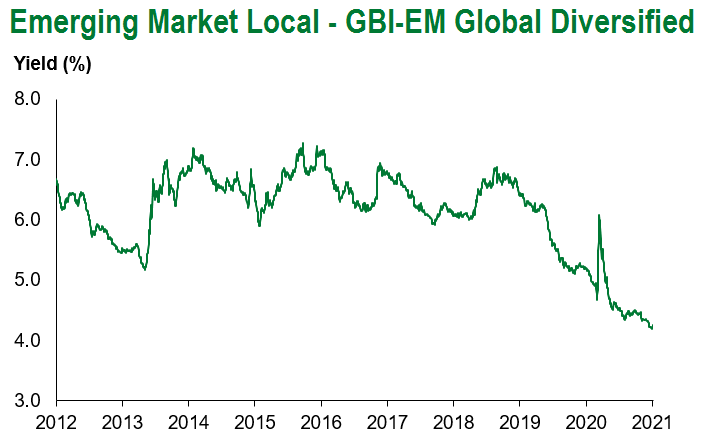
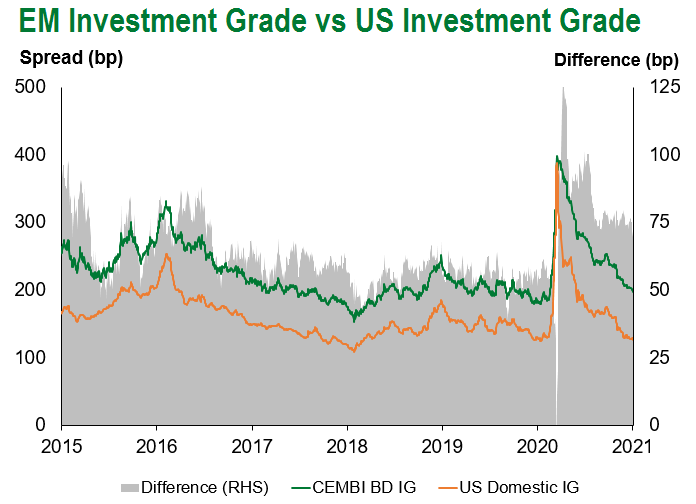
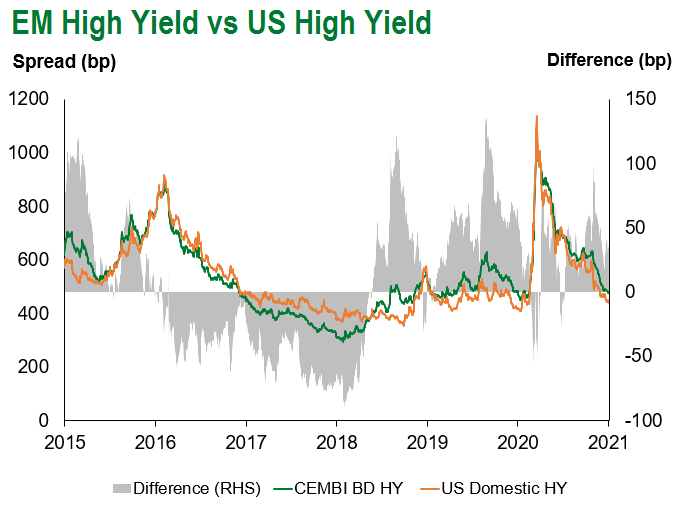
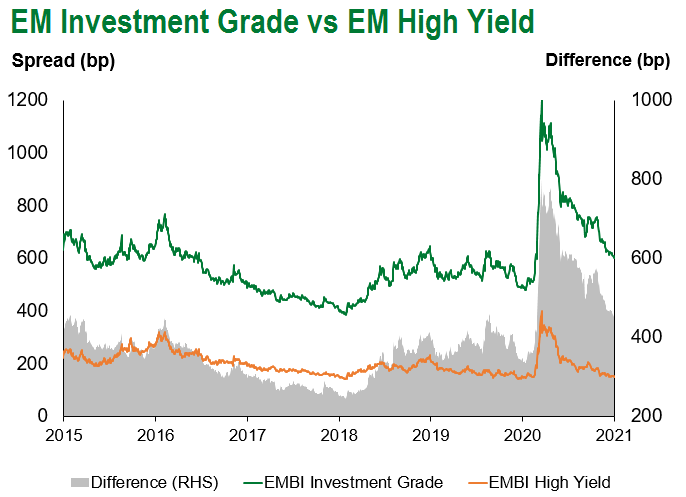
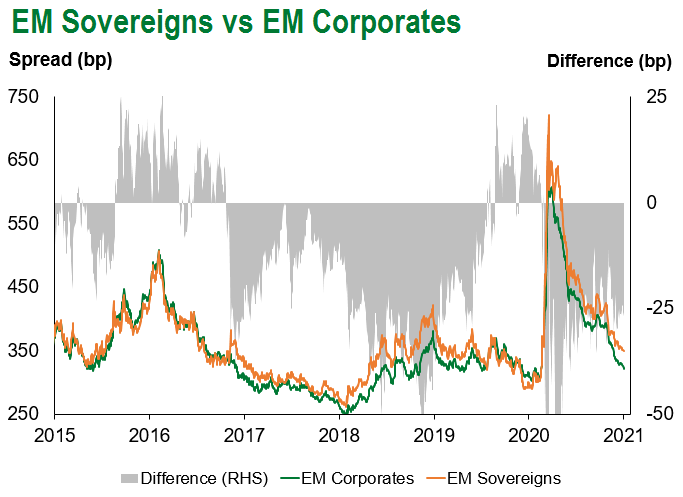
Emerging Markets Flows
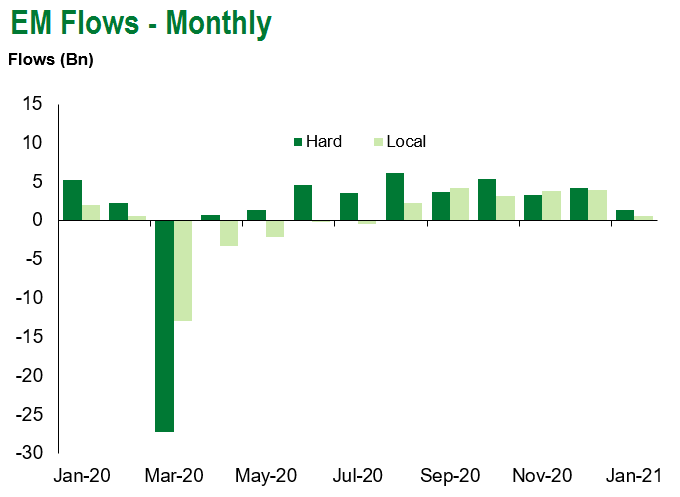
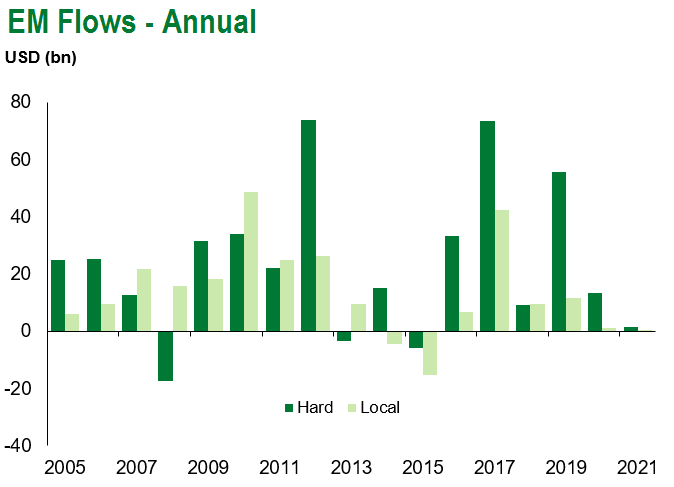
Source for graphs: Bloomberg, JPMorgan, Gramercy. As of January 8, 2021.
COVID Resources
Emerging Markets COVID-19 Case Summary
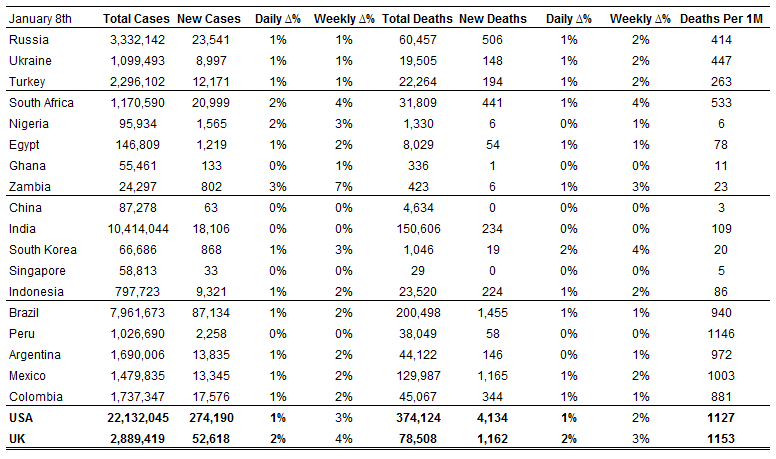
Source: Worldometer as of January 8, 2021.
Additional Crisis Resources:
Johns Hopkins COVID-19 Case Tracker
For questions, please contact:
Kathryn Exum, Senior Vice President, Sovereign Research Analyst, [email protected]
Petar Atanasov, Senior Vice President, Sovereign Research Analyst, [email protected]
Tolu Alamutu,CFA, Senior Vice President, Corporate Research Analyst, [email protected]
James Barry, Vice President, Corporate Research Analyst, [email protected]
This document is for informational purposes only. The information presented is not intended to be relied upon as a forecast, research or investment advice, and is not a recommendation, offer or solicitation to buy or sell any securities or to adopt any investment strategy. Gramercy may have current investment positions in the securities or sovereigns mentioned above. The information and opinions contained in this paper are as of the date of initial publication, derived from proprietary and nonproprietary sources deemed by Gramercy to be reliable, are not necessarily all-inclusive and are not guaranteed as to accuracy. This paper may contain “forward-looking” information that is not purely historical in nature. Such information may include, among other things, projections and forecasts. There is no guarantee that any forecasts made will come to pass. Reliance upon information in this paper is at the sole discretion of the reader. You should not rely on this presentation as the basis upon which to make an investment decision. Investment involves risk. There can be no assurance that investment objectives will be achieved. Investors must be prepared to bear the risk of a total loss of their investment. These risks are often heightened for investments in emerging/developing markets or smaller capital markets. International investing involves risks, including risks related to foreign currency, limited liquidity, less government regulation, and the possibility of substantial volatility due to adverse political, economic or other developments. The information provided herein is neither tax nor legal advice. Investors should speak to their tax professional for specific information regarding their tax situation.